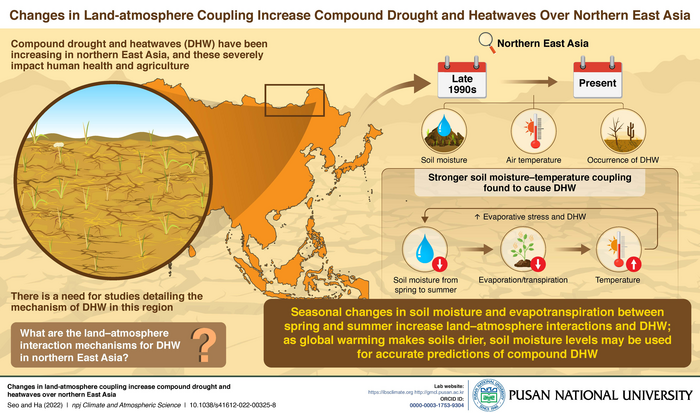With global warming on the rise, the severity and frequency of extreme weather events are also rising dramatically; this includes an increase in the number of compound extreme events. The latter term describes scenarios in which bad weather and climate events combine together, making the event more devastating than a separate weather and climate event. Compound drought and heatwaves (DHWs), for example, can cause massive damage to society through agricultural losses, wildfires, and deaths. Thus, there has been a lot of research into the mechanisms of these DHWs based on the interaction between land and the atmosphere. However, most previous studies have primarily focused on Europe, with little research looking at DHW mechanisms in northern East Asia, a region that has been experiencing an increased occurrence of DHWs since the late 1990s.

Credit: Kyung-Ja Ha from Pusan National University, Korea
With global warming on the rise, the severity and frequency of extreme weather events are also rising dramatically; this includes an increase in the number of compound extreme events. The latter term describes scenarios in which bad weather and climate events combine together, making the event more devastating than a separate weather and climate event. Compound drought and heatwaves (DHWs), for example, can cause massive damage to society through agricultural losses, wildfires, and deaths. Thus, there has been a lot of research into the mechanisms of these DHWs based on the interaction between land and the atmosphere. However, most previous studies have primarily focused on Europe, with little research looking at DHW mechanisms in northern East Asia, a region that has been experiencing an increased occurrence of DHWs since the late 1990s.
Fortunately, a team of researchers led by Professor Kyung-Ja Ha from Pusan National University in South Korea, has stepped in to bridge this gap. In their paper published on 15 December 2022, in Volume 5 of npj Climate and Atmospheric Science, the team looked at the occurrence of DHWs in northern East Asia by exploring the soil moisture–temperature coupling. According to Prof Ha, “Regional differences in temperature and precipitation can have a large impact on compound extreme events. By looking at the connection between soil moisture and air temperature, we were able to find the land-atmosphere interaction that serves as the mechanism for the occurrence of DHWs in this specific region.”
The team studied the aforementioned data, along with the occurrence of DHWs for regions in northern East Asia, like parts of northern China and eastern Mongolia, from 1980 to the present day. They found that, since the late 1990s, the continuous lack of moisture in the soil from spring to summer led to reduced evaporation and transpiration of water from the soil, which increased evaporative stress and amplified heatwaves, triggering a compound DHW that led to a further reduction in soil moisture. This increased moisture–temperature coupling enhances land–atmosphere interactions, leading to compound DHWs in the region.
“Compound DHWs can cause damage, often times more than either droughts or heatwaves alone, thus understanding them is important for society to better handle the risks associated with these events. As global temperatures keep increasing, soil moisture deficits are bound to increase, causing more DHWs in the region. Understanding and predicting them is going to be of utmost importance. Our study shows that soil moisture may be used to predict the occurrence of DHWs in the region,” concluded Prof Ha.
Understanding the complicated dynamics of compound extreme events is crucial for societal safety, and this study takes us one step closer towards this goal. We can then learn to combating the increasing risks associated with extreme events, especially in the face of global climate change.
***
Reference
DOI: https://doi.org/10.1038/s41612-022-00325-8
Authors: Ye-Won Seo1,2, and Kyung-Ja Ha1,3
Affiliations:
1Center for Climate Physics, Institute for Basic Science
2Pusan National University
3BK21 School of Earth and Environmental Systems, Pusan National University
Lab Website: https://ibsclimate.org http://gmcl.pusan.ac.kr
ORCID ID: 0000-0003-1753-9304
About Pusan National University
Pusan National University, located in Busan, South Korea, was founded in 1946, and is now the no. 1 national university of South Korea in research and educational competency. The multi-campus university also has other smaller campuses in Yangsan, Miryang, and Ami. The university prides itself on the principles of truth, freedom, and service, and has approximately 30,000 students, 1200 professors, and 750 faculty members. The university is composed of 14 colleges (schools) and one independent division, with 103 departments in all.
Website: https://www.pusan.ac.kr/eng/Main.do
About the authors
Prof. Kyung-Ja Ha is an expert in climatic extreme and monsoon hydrology at Pusan National University. She joined the department of atmospheric sciences as a faculty member in 1994. Her research group has been leading the research on monsoon dynamics, climate physics, and boundary layer physics. She has also been working at the IBS Center for Climate Physics (ICCP) with Prof. Axel Timmermann (director of ICCP) since 2017 as an affiliated professor. Dr. Ye-Won Seo (ICCP) has co-authored this article with the corresponding author. She is an expert in climate physics and dynamics, developing mechanisms for extremes such as heatwaves, droughts, and compound climatic hazards.
Journal
npj Climate and Atmospheric Science
DOI
10.1038/s41612-022-00325-8
Method of Research
Observational study
Subject of Research
Not applicable
Article Title
Changes in land-atmosphere coupling increase compound drought and heatwaves over northern East Asia
Article Publication Date
15-Dec-2022
COI Statement
The authors declare no competing interests.





